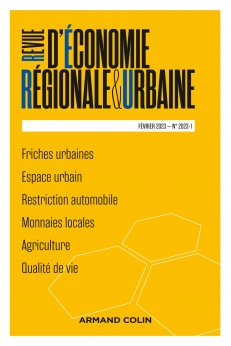
REVUE D'ÉCONOMIE RÉGIONALE ET URBAINE (1-2023)
Pour acheter ce numéro, contactez-nous
Recevez les numéros de l'année en cours et accédez à l'intégralité des articles en ligne.
L’article s’intéresse aux nouvelles formes d’agriculture, concept issu essentiellement de la presse généraliste et qui correspond à des formes innovantes ou réinventées d’agriculture comme la permaculture, l’aquaponie, la culture sur toits, dans les parkings ou dans des fermes verticales. Il se demande s’il s’agit d’un nouveau modèle agricole au sens où l’entend la littérature. En se basant sur le corpus théorique des logiques institutionnelles et en s’appuyant sur une double analyse textométrique et bibliométrique de la presse, il montre que les nouvelles formes d’agriculture sont une grappe de modèles dont les contours sont évolutifs. L’article contribue ainsi à la recherche sur la coexistence des modèles agricoles et met en évidence le rôle de la presse dans la fabrique des modèles.
This article focuses on new forms of agriculture, a concept that has emerged mainly from the press and that corresponds to innovative or reinvented forms of agriculture such as permaculture, aquaponics, rooftop farming, parking lots or vertical farms. We explore whether the concept constitutes a new agricultural model as defined in the literature. From a theoretical perspective, our study is anchored in the framework of institutional logics. Methodologically, we employ a textometric study using the software program Iramuteq and the press articles as a corpus. We also carry out an analysis of the composition of the corpus in terms of the number of articles published according to date and the profile of the press outlet that publishes them. Our findings show that the press articles contain words associated with four different logics: stakes, territorialization, agronomic concerns, and communication. The analysis of the corpus composition shows that the number of publications about new forms of agriculture has grown recently and especially from an urban perspective. However, articles about the topic from a rural perspective also exist. Our findings, therefore, highlight the divergences among institutional logics and, above all, show the great plasticity of the NFA, whose contours vary according to the press publications and over time. In sum, we show that new forms of agriculture are in fact a cluster of models which are still are evolving. Our article thus contributes to research on the coexistence of agricultural models and underlines the role of the press in the modelling of them.